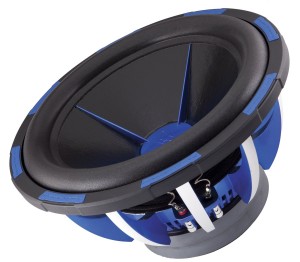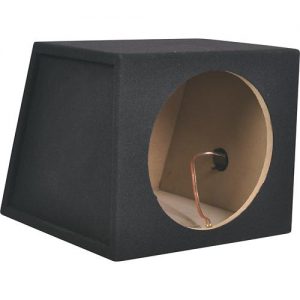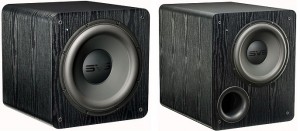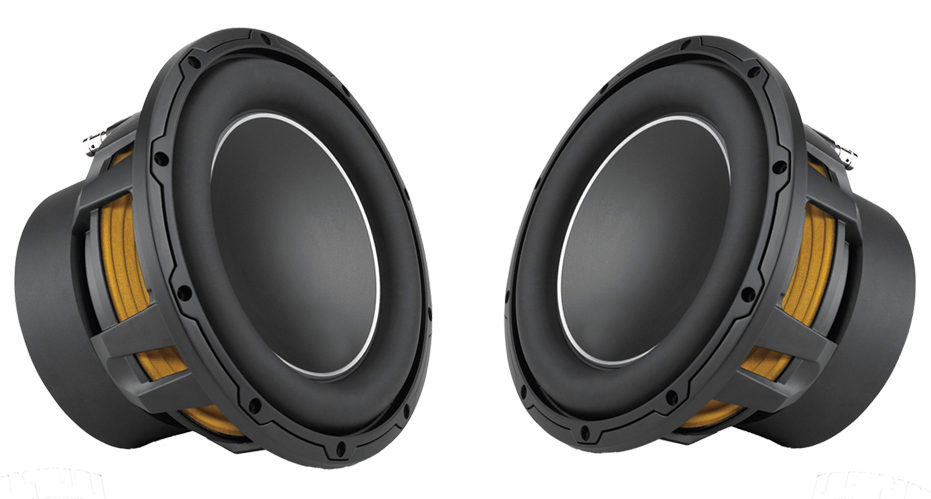Subwoofer speakers are designed solely to produce low-frequency sounds (bass). Bass is an integral part of the stereo experience, giving your audio depth and realism. Every car stereo system includes factory-installed subwoofers, but they are often too small to optimally handle low frequency sounds
 Difference between Woofer & Subwoofer
Difference between Woofer & Subwoofer
“Woofer” is a term used to describe the actual driver of subwoofers. Technically, a subwoofer consists of one or more woofers installed in a subwoofer box or enclosure. The box acts as a resonance chamber, providing more air pressure to the back of the speaker cone, which affects the sound pressure level (SPL) and causes the bass sounds to have more impact or volume.
Do differently shaped subwoofers produce different sounds
Somewhat. Triangular and rectangular subwoofers are shaped more for style than anything else. Triangular subwoofers can fit in spaces where round speakers cannot. Round subwoofers do produce more accurate sounds, but subwoofer cone construction is probably more important than shape when it comes to sound quality.
What factors can affect subwoofer performance
 The enclosure type, cone material, impedance, frequency response, and power rating can all affect your subwoofer’s performance. If you want really deep bass, you’ll want a very low frequency response. Subwoofers in sealed enclosures have a lower frequency response than other speakers, and the larger the subwoofers, the better they can reproduce low bass frequencies.
The enclosure type, cone material, impedance, frequency response, and power rating can all affect your subwoofer’s performance. If you want really deep bass, you’ll want a very low frequency response. Subwoofers in sealed enclosures have a lower frequency response than other speakers, and the larger the subwoofers, the better they can reproduce low bass frequencies.
How much power does my subwoofer require
Subwoofers have power ratings, measured in watts. This is usually labeled as the RMS output. You’ll want to pair your subwoofer with an amp of a similar rating. The higher the RMS is on both the amp and the subwoofer, the higher volume you can play the audio at without damaging the woofer or the amp.
The importance of subwoofer enclosures
Uniquely with subwoofers, the enclosure also plays an active role in creating the sound. This is because of something called the Helmholtz resonance. Just as when you blow air into a bottle neck, a vented subwoofer enclosure will channel the air pressure created by the back side of the driver in such a way as to produce a low tone that reinforces the overall bass sound. And just as it’s possible to tune a bottle to create a different pitch by either decreasing the volume of air in the chamber by filling it with air or the diameter of the neck of the bottle by covering part of it, bass reflex vents can be tuned to create a frequency response that matches that of the subwoofer.
The Subwoofer Advantage
When designed and used appropriately, subwoofers can be extremely effective and very convenient. Equally, though, it is very easy to destroy any chance of good monitoring quality with an inappropriate or badly set-up subwoofer — and it is worth stating that I have probably seen nine unsatisfactory installations for every good one!
 Poor subwoofer installations usually suffer from too much, or poorly defined, bass. Often there is an obvious ‘hole’ in the frequency spectrum in the crossover region between the satellite speakers and the subwoofer. It is the ‘integration’ through this crossover region that really makes or breaks the system as a whole.
Poor subwoofer installations usually suffer from too much, or poorly defined, bass. Often there is an obvious ‘hole’ in the frequency spectrum in the crossover region between the satellite speakers and the subwoofer. It is the ‘integration’ through this crossover region that really makes or breaks the system as a whole.
The worst kind of subwoofer system will only provide a boomy sound, regardless of the pitch or dynamics of the bass instrument, and the bass might thus appear to be slow or late relative to the main speakers. On the other hand, a well-designed and well-configured system will usually enable more accurate imaging, and have a clearer, more transparent mid-range (thanks to lower distortion and intermodulation levels) and higher overall output than could be achieved with the satellites alone.
Subwoofer Cabinet Types
While it is relatively easy to generate high levels of bass over very small bandwidths (and that’s what most cheap subwoofers tend to do), designing something that can generate a high output over a broad bandwidth, with very low distortion, and remain a sensible size, is pretty tricky. Creating low-frequency sound at studio replay levels requires the movement of a lot of air. This requires a powerful amplifier, a very large bass driver (or several smaller ones), and a lot of diaphragm displacement.
An easy way of achieving high efficiency is to place the driver in what’s called a ‘band-pass cabinet’. This is essentially a resonant, tuned box, with the driver hidden inside and the sound escaping through one or more ports. You see these quite commonly on cheap home theatre systems and in car ‘boom boxes.’ Although efficient (for which read loud!), this kind of design always tends to sound boomy, with a one-note kind of response. This is great for film explosions and crashes, but is not much use if you want to hear which notes the bassist is playing, so it is best avoided for serious monitoring duties.
The majority of subwoofers employ some form of ‘reflex’ design, which combines practical efficiency with useably wide bandwidth, and in convenient sized enclosures. The design principles are thoroughly understood, with the front of the driver radiating directly and its rear contributing via the enclosed cabinet volume through one or more ports. Not all reflex designs are born equal, but most studio-quality subs will be of this kind of design.
A rather less common alternative is the ‘closed box’ design. The cabinet is sealed, and only the front side of the driver contributes the sound. Efficiency is relatively low, and significant demands are placed on the amp and driver (the latter needs to be able to cope with unusually large excursions). However, this approach has considerable benefits in terms of its phase response, timing and distortion. Another close variation on this theme is the ‘transmission line’ approach, which aims to combine the best elements of both sealed and reflex cabinets. These two types tend to be the most expensive, but also the easiest toalign and integrate, and with the most accurate sound.
Don’t be fooled by the size of the subwoofer. Bigger doesn’t necessarily mean better, or even greater low frequency extension, although it does usually equate with louder; that business about needing to move a lot of air, again.


Comments 3
“magnificent points altogether, you just gained a emblem new reader. What would you recommend about your put up that you made a few days in the past? Any certain?”
hi, Just wanted to let you know that I do everything myself such as design and constuct the sub filters and build the sub boxes. I have found that the sealed box gives a smoother or hi fi bass sound, the ported box sounds more boomy and is very critical in tuning, so I dont bother with it.
Overall sub appears to be very critical anyway. I agree with what you say in your article about
it. I think the driver itself is the most critical part of the equation. To get a non- boomy bass response, it should have a low QTS and low fs ( below 50hz) I recon. also the compliance should be quite if it is a small driver ofcourse. I am using a 8inch driver at the moment in a 1 cu.ft box- powered by a 50wrms mosfet amp. It sounds quite good most of the time but sometimes the bass is a bit boomy. I think it depends on the program content as well.
Anyway, thats the end of my comments for today. It would be great to hear back from you sometime, you can reply to my email address if you wish, I live in New Zealand by the way.
Best Regards.
Author
Hi,
Thanks for the comments. Myself i’m also using a 10inch driver on a sealed cabinet and it delivers an impeccable sound quality. My setup is 400rms from the amp which has a crossover where you can vary the frequency (40-120Hhz). And my sound driver is 350 watts rms.
I live in Kenya, Nairobi to be specific.
Thanks again.